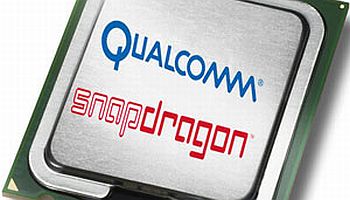Qualcomm Restyles Snapdragon Chip For Phones And Tablets

Qualcomm has redesigned the Snapdragon chip to deliver five times the performance at 75 percent less power
Qualcomm has introduced a faster version of its Snapdragon processor, according to media reports. The new chipset, Qualcomm’s first to be based on a 28-nanometer manufacturing process, is intended for smartphones and tablets and will feature a new CPU core.
”The MSM [Mobile Station Modem] 8960 will be a dual-core chip using an upgraded CPU core based on a new micro-architecture that delivers approximately five times the performance of the original Snapdragon chip at 75 percent less power,” according to an EETimes report.
Upgraded Graphics And Connectivity
 The article adds that the newest Snapdragon chip will also feature an integrated multi-mode modem with support for Long-Term Evolution (LTE), the 4G technology. Upgraded graphics capabilities will reportedly offer four times the performance of the original chip, plus integrated connectivity for WLAN, GPS, Bluetooth and FM radio. The processors are scheduled to start shipping in 2011.
The article adds that the newest Snapdragon chip will also feature an integrated multi-mode modem with support for Long-Term Evolution (LTE), the 4G technology. Upgraded graphics capabilities will reportedly offer four times the performance of the original chip, plus integrated connectivity for WLAN, GPS, Bluetooth and FM radio. The processors are scheduled to start shipping in 2011.
Qualcomm processors are currently in a number of high-end smartphones, such as the Motorola Droid and HTC Evo 4G, and the company said that its chips are in the majority share of Android-running handsets. Behind the market-share-losing Symbian, Google’s fast-rising Android is now the second-largest mobile operating system in the world.
In June, Qualcomm announced its first dual-CPU Snapdragon chipsets, MSM8260 and MSM8660, which run at up to 1.2GHz. The former was designed to work with HSPA+ networks and the latter for HSPA+/CDMA200 1xEV-DO Rev B.
The new MSM8960 chip is based on ARM architecture, EETimes reported, adding that Qualcomm licences the architecture but adds its own touch. Qualcomm did not offer further details regarding ARM, nor on the foundry that will create them.
In March, building on the success it has had in the PC market, Qualcomm announced it would begin adding LTE to the connectivity options supported by its Gobi modems and start work on expanding into new mobile markets, such as e-readers and netbooks. Now, with the number of tablets coming to market numbering more than 30 brands and beginning to skim market share from netbooks and even mobile PCs, the iPad follow-ups are a natural market for Qualcomm to set its sights on.
On November 3, Qualcomm announced its largest MSM chipset volume shipments and record earnings per share for its fiscal fourth quarter of 2010.
“In the coming year, we expect continued strong growth in CDMA-based device shipments, including smartphones and other data-centric devices, driven by the global adoption of 3G and accelerating consumer demand for wireless data,” Paul E Jacobs, chairman and CEO of Qualcomm, said in a statement. “With our industry-leading chipset roadmap, broad licensing programme and increasing number of global partners, we are well positioned to take advantage of these industry trends.”